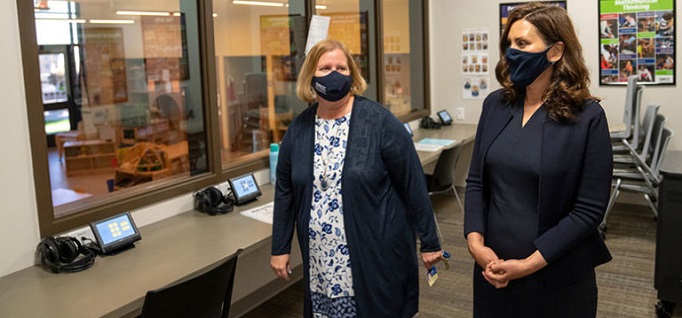Campus child care helps student parents
By Joan Mooney
September 1, 2021
Colleges use different approaches to child care to serve parenting students
A few years ago, some community colleges cut back on child-care services as demand fell. But since the pandemic began, need has grown as parents of young children found it hard to study at home with their children underfoot or they had to find affordable care while they worked.
Colleges have different approaches to child care. Some, like Clark College in Washington and Grand Rapids Community College (GRCC) in Michigan, have a child-care center right on campus. At those two colleges and some others, the child-care center is coordinated with students in the early childhood education program, who use the center as a learning lab.
Below is a sampling of child-care services at a few community colleges.
Kudos from the governor
The Fratzke Early Childhood Learning Laboratory at Grand Rapids Community College made the news recently when Michigan Gov. Gretchen Whitmer gave a speech there promoting access to child care for families throughout the state. In an event sponsored by the Early Neighborhood Learning Collaborative (ELNC) in Grand Rapids, Whitmer called the college’s Learning Lab “phenomenal.”
The child-care center has been part of the college for nearly 50 years. It rented space in a local church for several years until 2017, when the new building was completed on campus and the center moved there. The center is part of the college’s education department.
Parents with children in the center can be students (whose spaces are subsidized), college staff or members of the community, said Melissa Boman, director of the Fratzke center. The center has received some CCAMPIS funds to help student parents pay for child care.
The center also receives funding through ELNC, a local nonprofit that provides funding for early childhood education for at-risk families. It also works with the Great Start Readiness Program, a state program for 4-year-olds from families whose income is 250% below the poverty level.
The center closed for four months at the beginning of the pandemic. When it reopened, a lot of processes had to be changed, said Becky Brinks, head of the college’s education department.
The preschool classrooms housed half the number of children they had previously, 55 instead of the usual 105. More of the education majors were observing children from a booth instead of interacting with them directly. Strict cleaning protocols were put in place, and ventilation was increased.
Enrollment was limited during the pandemic to keep groups small, Brinks said. This fall, the center plans to be back to full capacity.
“There’s a huge need,” Brinks said. Twelve of the spots are reserved for student families. “There are very long waiting lists for private pay slots.”
Continued challenges
The child-care center on the main campus of Clark College also has a long history. It opened during World War II.
“It’s about student retention and motivation, and support for children,” said Michele Volk, director of child and family studies at the college. The center is also open to families in the community, and that enables student families to pay on a sliding scale, Volk said.
“We always maintain 65% or more spaces available to student parents because that’s part of our mission,” she added.
At its lowest point at the start of the pandemic in April 2020, the center had just 25 children enrolled in the center, a big drop from 131 in February. Today, 76 children are enrolled. There can be a waitlist for non-student families.
The center has dealt with plenty of challenges during the pandemic.
“The hardest part is tracking every week what changes we need to respond to,” Volk said. “We’ve put in place several procedures – screening tools, temperature checks, limiting the number of children in a classroom.
“We have maintained stable groups of cohort. The child is in one indoor space and one outdoor space so they’re not mixing with other children indoors,” Volk said. “That’s been helpful.”
The child-care center serves children aged 1 to 5 years old, with a summer camp for 5- to 10-year-olds. Last year, when elementary schools were teaching remotely, the center’s school-aged classroom stayed open for the full year.
“Families were going through so much uncertainty, they didn’t know what choices to make,” Volk said. “To have that sense of continuity for their children and families was very helpful.”
That program will not continue this year as elementary schools return to full-time, in-person learning. Volk anticipates enrollment of 75 to 80 children in the child care center, about half the usual level.
“So we’re looking at a significant challenge,” she said. “With change in the [delta] variant, some families or staff have communicated hesitation.”
There’s more to the story! Read the full article in CC Daily.



